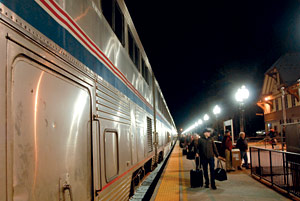The Empire Builder was a few minutes late arriving in Whitefish the morning of Sept. 13. Passengers waiting on a platform for a late Amtrak train have been a common sight in Northwest Montana this summer and last month the westbound train had a zero percent on-time performance.
Many of the delays were due to work completed on the track by its owner, BNSF Railway. And for passenger rail advocates, slow trains are the least of their concerns, when compared to the potential for shrinking federal funds.
Amtrak’s Empire Builder runs everyday between Chicago and Seattle/Portland, making stops in East Glacier Park, Essex, West Glacier, Whitefish and Libby. According to Amtrak spokesperson Marc Magliari, the passenger train is on time about 75 percent of the time. But in August, the westbound train was never on schedule and the eastbound run’s on-time rate was just 16.1 percent. Track work and hot weather in eastern Montana caused most of the delays, Magliari said.
The train was also chronically late last summer due to flooding in North Dakota. Water severed the line near Minot, forcing Amtrak to cancel or shorten the Empire Builder’s run.
“It’s unfortunate that we’ve had two summers of unsatisfactory performance,” Magliari said. “In the end, it’s like any construction project, be it on U.S. Highway 2 or in your neighborhood – there will be delays.”
The construction is part of a $122 million track rebuild program BNSF is doing in Montana, according to railroad spokesperson Gus Melonas. He said work is expected to continue through the fall, but the schedule will be adjusted to allow Amtrak and the 40 freight trains that use the tracks everyday to stay on time.
“Montana is a significant part of the BNSF system,” Melonas said. “Those tracks take a beating.”
Late trains are of little concern to passenger rail advocates. Earlier this month, Republicans made news when their party platform called for the end of government subsidies for Amtrak.
“Amtrak continues to be, for the taxpayers, an extremely expensive railroad. The public has to subsidize every ticket nearly $50. It is long past time for the federal government to get out of (the) way and allow private ventures to provide passenger service to the northeast corridor. The same holds true with regard to high-speed and intercity rail across the country,” the platform read.
 |
|
Passengers unload from an Amtrak train after its early morning arrival at the Whitefish station earlier this year. file photos by Lido Vizzutti | Flathead Beacon |
Sean Jean-Gail, vice president of the National Association of Railroad Passengers, said privatizing Amtrak would be a death sentence for long-distance trains like the Empire Builder.
Jean-Gail said because of the many miles covered by the Empire Builder, it “doesn’t have a shot at breaking even.”
“When you look at rural communities served by the Empire Builder, you’ll note that it’s often the only transportation option, other than a car,” he said. “The Empire Builder is really a public service and it needs to be viewed as such.”
In 1971, Amtrak was established to offer intercity passenger service. Although it is not technically a government agency, Amtrak is owned and funded by the government. Before that, private freight railroads operated passenger trains, but got rid of them because they were losing money.
Jean-Gail argued that all public transportation gets some sort of government funding, and Amtrak should not be different. He believes much of what is being proposed is election-year rhetoric.
“It’s good campaign rhetoric, but the votes are not there (in Congress) to cut Amtrak’s funding,” he said.
Magliari said Amtrak’s primary goal is to get trains like the Empire Builder back on schedule to serve a growing number of riders. Last week, the railroad announced it was on track to break last year’s ridership record of 30.2 million passengers.